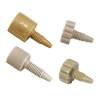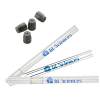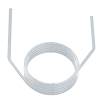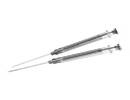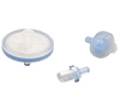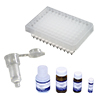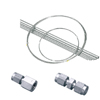2. How to Change Elution Patterns
The quantification of a target compound becomes more difficult if coexisting compounds overlap. Such a problem can be solved by changing the elution pattern. Some of the methods shown in this section might be useful when elution order designated by an official method cannot be achieved.
2-1. Changing the pH of the Mobile Phase
The retention times of ionic compounds may change according to the pH of the mobile phase. Figure 2-1 shows an example of analysis of a sample containing both ionic and non-ionic compounds. And, as shown in Figure 2-2, the retention time of ionic compounds varies dramatically with pH around their dissociation constant (pKa). This method can be used to intentionally change the retention time to some extent.

2-2. Changing the Type of Organic Solvent in Eluent
The change of organic solvent may influence not only the retention but also the elution order of the compounds. For example, methanol and acetonitrile are the most frequently used solvents in reversed phase mode. If your analytes are insufficiently separated with methanol or acetonitrile, alternatively using tetrahydrofuran (THF) or 2-propanol (IPA) might improve the separation.

2-3. Difference in Stereo Selectivity
One of the column characteristics is stereo selectivity, which shows how much the column recognizes difference in steric structures. In general, the more densely the surface of the packing material is covered with the functional groups, the higher stereo selectivity is. For example, even with the same functional groups (e.g. ODS), elution pattern changes if stereo selectivity is different. Attention must be paid when using a highly hydrophobic column with a water rich mobile phase because the retention time may be unstable.
2-4. Using the π Electron Interaction
If the functional groups of the column possess π electrons, such as benzene rings, analytes are retained not only by hydrophobic interaction but also by π electron interaction. As a result, the elution pattern of these columns often differ from ODS or C8 columns, the functional groups of which are alkyl chains. This kind of retention is very effective to change elution pattern of those compounds which contain double bonds or benzene rings.

2-5. Using the Ion Repulsion
When there is an electric charge on the packing material surface like in non end-capped columns, an electrostatic interaction may arise and the elution of the compounds may be fast.



